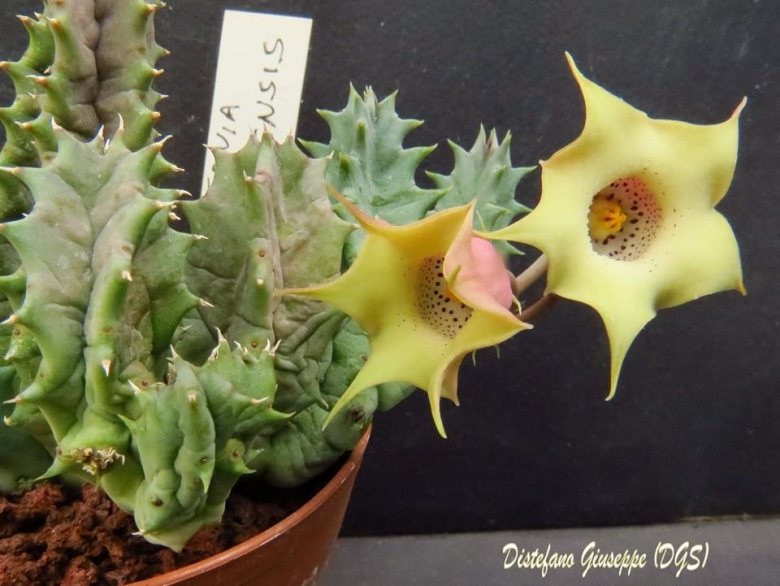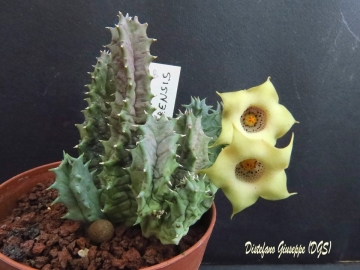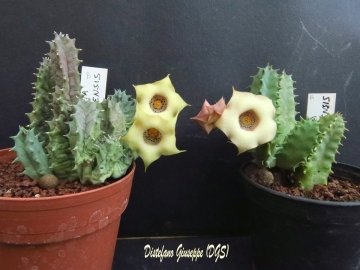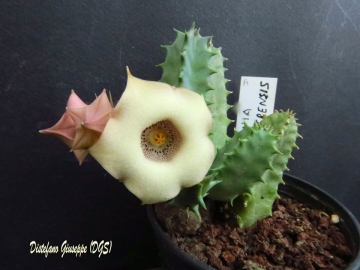Accepted Scientific Name: Huernia quinta var. blyderiverensis L.C.Leach
Excelsa Taxon. Ser. 4: 178 (1988)

Huernia blyderiverensis (Huernia quinta var. blyderiverensis) Photo by: Giuseppe Distefano
Origin and Habitat: Huernia quintaSN|30727]]SN|30725]] var. blyderiverensis (Huernia blyderiverensisSN|30725]]SN|30727]]) is endemic to the Republic of South Africa (Limpopo - Olifants River, Ohrigstad River; Mpumalanga - Blyde River Canyon).
Habitat and ecology: Hills along the southern banks of the Olifants River to the slopes of the mountains overlooking the Blyde River Canyon. This range-restricted (Extent of occurence193 km²), habitat specialist is endemic to Poung Dolomite Mountain Bushveld. It is locally very abundant and occurs in rocky sites, where it grows in shallow soils on ledges and rock outcrops. It is not threatened. The vegetation in this area include the following species: Encephalartos dolomiticus and Encephalartos inopinus (small trees); Melhania integra (low shrub); Delosperma vandermerwei and Euphorbia grandialataSN|18792]]SN|18792]] (succulent shrubs); Barleria dolomiticola and Lotononis pariflora (herbs); Brachystelma minor, Brachystelma parvulum, Gladiolus dolomiticus and Gladiolus pavonia (geophytic herbs); and Aloe branddraaiensis, Aloe monotropa and Gasteria batesianaSN|948]]SN|948]] var. dolomitica (succulent herbs).
Synonyms:
See all synonyms of Huernia quinta
back
Accepted name in llifle Database:Huernia quinta (E.Phillips) A.C.White & B.SloaneStapelieae (White & Sloane) ed. 2 3: 885 1937Synonymy: 2
Accepted name in llifle Database:Huernia quinta var. blyderiverensis L.C.LeachExcelsa Taxon. Ser. 4: 178 (1988)Synonymy: 2
back
Description: Huernia quintaSN|30725]]SN|30725]] var. blyderiverensis (Huernia blyderiverensisSN|30725]]SN|30727]]) is a small perennial succulent species with grey-green acutely-angled stems and showy cream flowers at the stem base. Huernia blyderiverensisSN|30727]]SN|30727]] is distinguished from Huernia quintaSN|30727]]SN|30725]] by the spotted (not transversely striped) larger corolla with curved spreading lobes, moreover the papillae are shorter (not bristle-tipped or with bristle less than 0.25 mm long) and the mouth of the tube is more constricted.
Derivation of specific name: As the name suggests this species is found in the vicinity of the worlds third largest canyon, the Blyde River Canyon (type locality) near the junction with Ohrigstad River, Mpumalanga, RSA.
History: This plant was discovered by Alan Percy-Lancaster by Ohrigstad River Blyde in about 1975. Larry Leach (1988) described it as a variation of Huernia quintaSN|30725]]SN|30725]]. Peter Bruyns treated it as a separate species (2005).
Subspecies, varieties, forms and cultivars of plants belonging to the Huernia quinta group
 Huernia quinta (E.Phillips) A.C.White & B.Sloane: Corolla broadly bell-shaped, up to 2,8 cm Ø, creamy-white banded with dark red. Lobes with bristle tipped papillae. Distribution: Limpopo, Mpumalanga, South Africa.
Huernia quinta (E.Phillips) A.C.White & B.Sloane: Corolla broadly bell-shaped, up to 2,8 cm Ø, creamy-white banded with dark red. Lobes with bristle tipped papillae. Distribution: Limpopo, Mpumalanga, South Africa.  Huernia quinta var. blyderiverensis L.C.Leach: has a spotted (not transversely striped) larger corolla with papillae not bristle-tipped and the mouth of the tube is more constricted. Distribution: Limpopo, Mpumalanga, South Africa.
Huernia quinta var. blyderiverensis L.C.Leach: has a spotted (not transversely striped) larger corolla with papillae not bristle-tipped and the mouth of the tube is more constricted. Distribution: Limpopo, Mpumalanga, South Africa.
Bibliography: Major references and further lectures
1) Bruyns, P.V. “Stapeliads of southern Africa and Madagascar.” Vol. I and II. Umdaus Press, Pretoria - Hatfield. 2005
2) L. C. Leach “A Revision of Huernia R. Br. (Asclepiadaceae)” Aloe, Cactus and Succulent Society of Zimbabwe, 1988
3) Iztok Mulej. Huernia blyderiverensis In Huernia.info. <http://www.huernia.com/Huernia/DP/H_blyderiverensis.php>
4) Doreen Court “Succulent Flora of Southern Africa” CRC Press, 01 June 2000
5) Urs Eggli, Leonard E. Newton “Etymological Dictionary of Succulent Plant Names” Springer Science & Business Media, 29 June 2013
6) Focke Albers, Ulrich Mev “Illustrated Handbook of Succulent Plants: Asclepiadaceae” Springer Science & Business Media, 06 December 2012
7) von Staden, L. 2009. Huernia blyderiverensis (L.C.Leach) Bruyns. National Assessment: Red List of South African Plants version 2015.1. Accessed on 2016/08/01 <http://redlist.sanbi.org/species.php?species=2642-134>
8) LEDET Reserve Management Documents: Wolkberg Nature Reserve (Strategic Plan) “Five-year Strategic Plane for the Wolkerg Nature Reserve, Limpopo Province, South Africa” <http://www.ncc-group.co.za/sites/default/files/u66/Wolkberg%20NR%20-%20DSP.pdf>
 Huernia blyderiverensis (Huernia quinta var. blyderiverensis) Photo by: Giuseppe Distefano
Huernia blyderiverensis (Huernia quinta var. blyderiverensis) Photo by: Giuseppe Distefano Huernia blyderiverensis (Huernia quinta var. blyderiverensis) Photo by: Giuseppe Distefano
Huernia blyderiverensis (Huernia quinta var. blyderiverensis) Photo by: Giuseppe Distefano Huernia blyderiverensis (Huernia quinta var. blyderiverensis) Photo by: Giuseppe Distefano
Huernia blyderiverensis (Huernia quinta var. blyderiverensis) Photo by: Giuseppe DistefanoSend a photo of this plant.The gallery now contains thousands of pictures, however it is possible to do even more. We are, of course, seeking photos of species not yet shown in the gallery but not only that, we are also looking for better pictures than those already present.
Read More... Cultivation and Propagation: Not difficult to grow. Huernias require moderately watering through the growing season but enjoy plenty of water and some fertiliser in hot weather, this helps them to flower freely. Water more sparingly in winter according to temperatures. But, as with most asclepiads, it is unwise to leave them wet in cold weather.
Frost Tolerance: It is usually recommended to overwinter them in warm conditions (at 10 deg) but despite the African origin they seem to grow well and flower without the extra heat which one might have thought necessary and occasional temperature near 0 deg. are tolerated if kept dry.
Potting medium: Since roots are quite shallow, use a cactus mix or add extra perlite or pumice to regular soil potting soil. A gritty, very free-draining compost is suitable, and clay pots help the plants to dry out between watering.
Pest and diseases: Huernia species vary in their susceptibility to rotting, but are generally fairly easy to grow, especially if kept pest-free. They are very susceptible to stem and root mealy bugs, and damage from these may well initiate fungal attack. If you do have problems with a stem or with basal rotting, you can reliably isolate the healthy parts, dry them off, and re-root them in moist compost.
Propagation: Easiest with stem cuttings. Allow cuttings to dry a day before planting. Stems must be laid (Not buried) on gritty compost and will then root from the underside of the stems. It can also be increased from seeds sowing in spring in moist, sandy peat moss. Barely cover seeds. Seeds germinate quickly.














